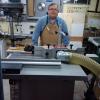My FaceBook page has recently been filled with ads for planners, sketchbooks, and other blank books. I don’t know why I would be targeted but it made me consider what I write down. One of them, the Monk’s Planner, described the advantages of living a better life by focusing on doing the important things. The planner has sections for a lot uplifting things one is supposed to benefit from writing down. I find such guided reflection a bunch of malarkey. On thing they did differently though that I think may be useful is to start each month with a double page for big goals, each week starts with a double page for more immediate goals, and each day a double page. If I used the Monk’s Planner, I would probably waste a lot of paper. But, the weekly and monthly double pages are something that I may add to my current system using spiral notebooks. Anyway, I have thinking this morning about what I write down and if I could do better. I thought I would pose the question to the group regarding what you find useful to write down, on what, and what do you keep.
My system involves three notebooks: a spiral notebook of lists, a spiral notebook of math, and a sketchbook. The book of lists consists of to-do lists and shopping lists. Sometimes it also has cutting lists and material estimates. These would probably be better kept in the math book but sometimes the lists book is the only paper I have with me. Every few months I make out a to-do list. It is an omnibus list of big and small items together. Things get added and scratched out until the page is too cluttered and then I start a new on the next clean page. The shopping list is a running list of things needed for the tasks at hand. The big box store is 30 minutes away. I try to get everything I need on each trip. A list really helps. The to-do list would probably benefit from categorizing tasks by size, the monthly list of big projects and subdividing the big one into smaller tasks for a week or a day.
The math book is probably not something everyone would do. I contend putting together cutting lists and material estimates is math and is good organization. I started with a tabular format that I read in a woodworking book and have continued with it. I have some from long ago projects. The plans bring back lots of memories of what I built and how I built it. At my age, it is fun and helpful. The other things in the math book are engineering calculations that I find useful. With my experience and library, they are not hard. I have things like load and deflection of a bookshelf, flow and pressure drop it a dust collection system, or heat loss from a building which are probably not of interest to most. I also do mechanical modeling of a bicycle wheel and related problems. It is a hobby in itself. I think I do better work, waste less material, and understand what I am doing better because I do the math. Of course, your mileage may vary.
The sketchbook is least used. I should draw more. On SMC, I have included pictures of sketches done for projects in most projects I post. It is was gets me through the thinking process of how to build something. Most of the time, the projects turn out very close to the initial sketch. I treasure the ones I still have.
So, what do you log?




 Reply With Quote
Reply With Quote







